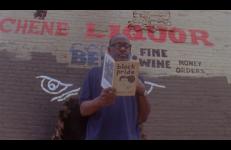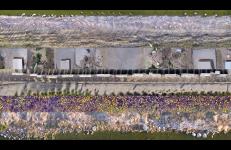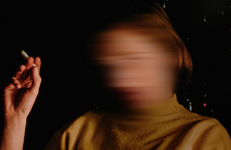Endless Dreams and Water Between is a feature film with four fictitious characters sustaining an epistolary exchange in which their “planetary thought” is woven with the physical locations they inhabit, visual and aural characters in themselves: the island of Manhattan, the island of Majorca, in Spain, and the islands and peninsula that form the San Francisco Bay Area. The characters’ reflections and dreams enact what could be described as “an archipelagic mind,” linking worlds, time, and space.
Memory
Over a montage of family photographs, Freed’s narration questions the consistency of memory and self over time, with Freed displaying a quizzical and sometimes hostile relation to her past. In a manner that recalls philosopher Roland Barthes’s poetic unraveling of photography—in particular photography’s power to bind memory and desire within a still image—Freed attempts to uncover the “stranger” that is her childhood self and discover how her past has shaped her present.
Kent Merritt waxing poetically about being one of the first four Black scholarship athletes at the University of Virginia.
This title is only available on Can You Move Like This: Black Fire.
Kent Merritt waxing poetically about being one of the first four Black scholarship athletes at the University of Virginia.
This title is only available on Can You Move Like This: Black Fire.
Broadcasters across Ireland and Britain have entered into a blackout strike. The workers are transmitting a programme bringing censored voices back onto the airwaves.
"In the late 1980s, as violence continues in the north of Ireland, censorship is increasingly being enforced on British and Irish television. In response, broadcasters have entered into a blackout strike, occupying several stations and transmitting a programme bringing censored voices back onto the airwaves."
Frances, a young Gay Indian (2 Spirit), played by Lacey Hill, is struggling with the aftermath of a gay basing. Through her friendship with her ex Jean, she gathers the strength to go out in public again. This video is a salute to the 70s and to Gay Indian movements which became 2Spirit/Indigiqueer communities.
Song performed by Lacy Hill.
Fluid Frontiers is the fifth and final film in the series entitled The Diaspora Suite, exploring Asili’s personal relationship to the African Diaspora. Shot along the Detroit River, Fluid Frontiers explores the relationship between concepts of resistance and liberation, exemplified by the Underground Railroad, Broadside Press, and artworks of local Detroit Artists.
The Fool melds varied footage while a narrator describes a brief encounter with a former love interest. A performance of a gymnastics routine merges with iconic Baroque paintings; club scenes mix with a day at the beach. Taking the viewer on a hazy, dream-like journey, the images at times seem to illustrate the story being recounted but elsewhere fail the narrator entirely: in one surreal moment, a large fig tree rolls across a hallway on a skateboard.
What happens when memory collapses into an unknown landscape? Upside-down train tracks merge and blur the distinction between reality and imagination.
Futures for Failures is a double narrative of failure: architectural and social. Archival footage from a demolition of the Pruitt-Igoe building in St. Louis manifests as the materialization of modernity’s failure. Meanwhile, an intimate voiceover recounts a moment of laughter erupting during a stranger’s funeral, staging anachronous conversation between the disappeared and the disappearing.
Flesh and blood souls breathe forth the colors of doubt, guilt and a hope for "peace of mind" in a world without moral directions... This video is about strength and weakness, done with human forms assembled and lovingly digitized.
This title comprises The Poet's Battle (2016), NightSchool (2015), Ascension (2013), Lost Blues (2014), and A Rented Space (2015) which were compiled into this form by Mike Kuchar in 2022.
Ground Effect is an investigation of the constantly shifting, 80km long line in Israel, where rainfall amounts to less than 200mm a year on average. This line, which aligns with the global desert belt, cuts from the east, near the West Bank, to the west, near the Gaza strip. It is where I grew up, an area divided between industrial scale agriculture, nature preserves, ancient and recent ruins, Bedouin towns, encampments and olive groves, artificial pine forests planted on contested lands, rural Jewish communities, and military practice zones.
A performer lip-synchs to archival audio featuring the voice of author and anthropologist Zora Neale Hurston as she describes her method of documenting African American folk songs in Florida. The flickering images were produced with a hand-cranked Bolex so that the lip-synch is deliberately erratic and the rear-projected, grainy, looped images of Masai tribesmen and women, recycled from an educational film, become increasingly abstract as the audio transforms into an incantation.
These are the ghosts of a haunted civilization, a culture of progress that hides the social and political horror behind the Olympic Games. These are the haunted figures in the Capitalocene era. A sinister dance of macabre abstraction. Part of the Hauntology series.
Here You Are Before the Trees is a three-channel synchronized video installation. A composite of the three channels presented side by side in one video is available from Video Data Bank for educational use only.
Here You Are Before the Trees traverses Indigenous presence in the Hudson River Valley, Wisconsin, and the areas in-between. Each screen focuses on different homelands and their complex relationships with history, landscape, power and institutional means of oppression.
Each year, crowds of Turkish, Australian and New Zealander tourists travel to Gallipoli, Turkey for a modern day pilgrimage. They honor their fallen soldiers who lost their lives in the Gallipoli/Çanakkale Campaign—one of the bloodiest conflicts of World War One—, which is considered as a defining moment in the establishment of the Turkish nation state as well as the beginning of national consciousness in Australia and New Zealand. With heightened emotions, they move around the historical battlefields, graves and war monuments with the help of guided tours tailored for each community.
Grieving the recent death of his father, filmmaker Cam Archer distracts himself with the regular photographing of a particular young man.
"Superimposing the stories of two women—the filmmaker’s late grandmother and the amateur filmmaker Joan Thurber Baldwin—Home When You Return explores the psychogeographies of mourning through a variety of modes, from documentary to melodrama. Emptied and put up for sale following its matriarch’s passing, the family home becomes the site of a winding tour through polymorphic representations of the past in media and memory." - NYFF Currents
"Despite the didactic promise of its title, Carl Elsaesser’s new film will not teach you how to complete this obscure action. The phrase itself, at once ridiculous and noble, is pleasure enough, and its tone fits perfectly on a work that walks a thin, dandyish path down the border of farce and elegy. Another pleasure: it isn’t about anything, though it’s of quite a lot. Of fathers (who might teach one how to run a trotline, or sit on a porch, or disappear); of other films (particularly a pair by adopted fathers Michael Snow and William E.
The Hundred Videos is a project undertaken by prolific video artist Steve Reinke, including 100 video works made from 1989-1996. Discussing death, sex, the body, philosophy, and contemporary art, The Hundred Videos defines a unique style of video-essay for the end of the 20th Century.
"Each disquieting image breaks down into a pixel, each pithy phrase into a word, and Reinke's stream of video-thought continues apace. The corpse won't stop talking."
— Jon Davies, Images Festival: Spotlight Essay, April 2018
The Hundred Videos is a project undertaken by prolific video artist Steve Reinke, including 100 video works made from 1989-1996. Discussing death, sex, the body, philosophy, and contemporary art, The Hundred Videos defines a unique style of video-essay for the end of the 20th Century.
"Each disquieting image breaks down into a pixel, each pithy phrase into a word, and Reinke's stream of video-thought continues apace. The corpse won't stop talking."
— Jon Davies, Images Festival: Spotlight Essay, April 2018
The Hundred Videos is a project undertaken by prolific video artist Steve Reinke, including 100 video works made from 1989-1996. Discussing death, sex, the body, philosophy, and contemporary art, The Hundred Videos defines a unique style of video-essay for the end of the 20th Century.
"Each disquieting image breaks down into a pixel, each pithy phrase into a word, and Reinke's stream of video-thought continues apace. The corpse won't stop talking."
— Jon Davies, Images Festival: Spotlight Essay, April 2018
The Hundred Videos is a project undertaken by prolific video artist Steve Reinke, including 100 video works made from 1989-1996. Discussing death, sex, the body, philosophy, and contemporary art, The Hundred Videos defines a unique style of video-essay for the end of the 20th Century.
"Each disquieting image breaks down into a pixel, each pithy phrase into a word, and Reinke's stream of video-thought continues apace. The corpse won't stop talking."
— Jon Davies, Images Festival: Spotlight Essay, April 2018
The Hundred Videos is a project undertaken by prolific video artist Steve Reinke, including 100 video works made from 1989-1996. Discussing death, sex, the body, philosophy, and contemporary art, The Hundred Videos defines a unique style of video-essay for the end of the 20th Century.
"Each disquieting image breaks down into a pixel, each pithy phrase into a word, and Reinke's stream of video-thought continues apace. The corpse won't stop talking."
— Jon Davies, Images Festival: Spotlight Essay, April 2018
A portrait of the Bosphorous Sea.
I Dream of the Bosphorous, originally presented as a four-channel video installation, is distributed by VDB as a single-channel video.



























